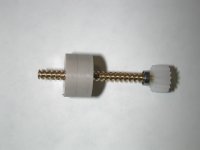Hi again 50BMG DUDE:
Regarding cutting custom tooling on the wire; here's my experience.
Turning tools are pretty easy compared to milling cutters.
I do have the benefit of having a seat of wire EDM CAM software (Mastercrap) that helps tremendously.
On that subject...it was WAY too expensive for what it does...a friend who posts on here uses an older version of Bobwire and does amazing work with it.
I doubt he paid a tenth of what that seat of Mastercam cost me.
As others (on a different thread) have pointed out, I was stupid!
So, to wire a turning tool:
I first model it in Solidworks with all the clearances modeled in.
Then I pull out a Parasolid and import it into Mastercam.
I prefer to program it using a strategy called "Complex Upper and Lower" whereby I program the upper contour, program the lower contour, put them together line by line with semicolons, and run the code.
This is only for tools where the relief is different on the trailing edge compared to the leading edge...weirdo threading tools are the best example.
Normal form tools just get cut with a single profile and a simple taper command.
Most wire CAM programs can run these complex shapes using a slightly different strategy that makes huge amounts of G01 code, but if your machine can handle it...who cares.
I learned my habit from when I was programming the paths in Mastercam Mill (all I had at the time) and it just stuck.
I'm an old fart who won't change my ways...I still don't know how to text message on an idiotphone, and I won't learn!
My Lovely Wife laughs at me.
Milling tools are more complex to make because ideally you want to wire the secondary clearance too and that involves rotating the tool and running different code for the secondary relief cuts so you don't booger the cut you made to establish the primary cutting edge and relief.
It varies as your profile changes...the relief that's parallel to the axis is different from the relief at right angles to the axis... if you just make them all the same you hack into your primary profile as you transition from radial to axial relief.
So the screwaround factor is immense compared to a lathe tool.
Additionally it makes a crappy cutter compared to grinding if you're making carbide cutters.
The reason is cobalt leaching at the cutting edge, so the carbide grains are not as tightly bound as they should be, and they crumble away early in the use of the cutter.
So I use it only when I must... to get me out of a jam.
On a last note:
I encourage you to take the trouble to get fluent with taper cutting on the wire...I've found it to be a real bacon-saver in the work I do.
In service to that, a CAM system has been of great benefit to me, and although I choked a bit at the price, ultimately it was worth it.
Cheers
Marcus
www.implant-mechanix.com
www.vancouverwireedm.com




 (think that is to preserve their mystic abilities)
(think that is to preserve their mystic abilities)